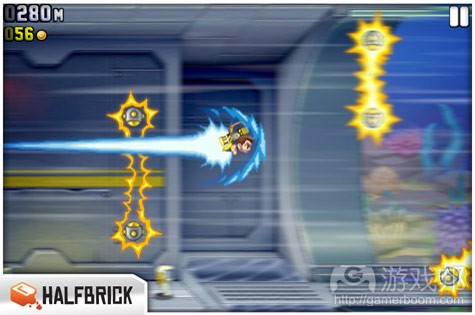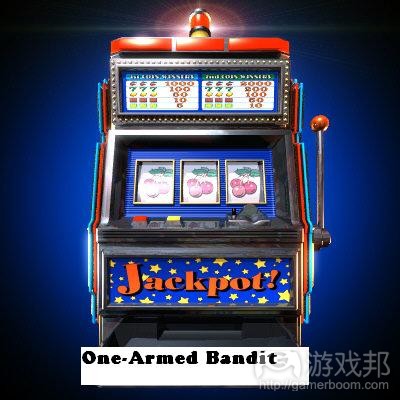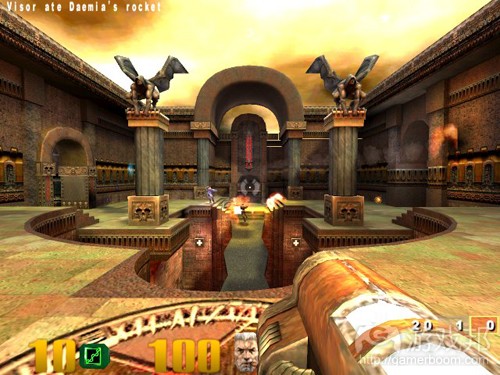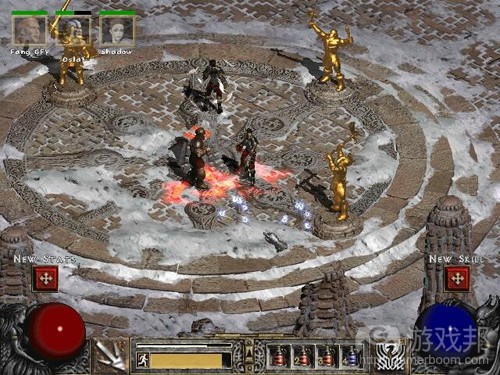改良旧机制和互动感有助于延长游戏寿命
作者:Alex Norton
游戏设计总是先往后看再往前看。有时是设计师有意为之,而有时是无心之举,但它总是会发生。每个绝妙的新想法都是构建于改善单个或多个老想法之上,最棒的游戏设计师都明白这点。
我最大的毛病之一是当有人跟我说“别重新发明轮子”(游戏邦注:这里指别白费力气做重复工作)时,他们往往会迅速为此举动感到后悔,因为我会开始高谈阔论,告诉他们如果没有人重新发明和改造轮子,我们就永远看不到轮胎、悬吊、辐条和胎面等,而这些东西都让轮子在生活中发挥更大的作用。
但是要重新改造轮子,就必须有个轮子作为对象,这就是我们在游戏行业中所做的事情。近期获得成功的Halfbrick Studios所开发的iOS游戏《Jetpack Joyride》便是绝佳的例证。
这是款很棒的游戏,所采用的模型显然取自当年“控制直升飞机别撞到隧道边缘”类型的游戏。他们借鉴了这个想法,用道具、成就和你能够获得的特殊装备等内容加以包装,制作出一款绝妙的游戏。他们重新改造了轮子,而事实证明他们做出了有效的产品。
这种方法是否总是有效?
这种方法并非总是有效。坦诚地说,有些过去的想法并不是那么棒。然而,有些想法不仅获得了令人称奇的成功,还经受住了时间的考验。
《雷神之锤3:竞技场》(发布于1999年)和《暗黑破坏神2》(发布于2000年)这两个截然不同的题材便是绝佳的范例。当然,历史上还有更多值得称道的游戏佳作,但这两款是我编写本文的研究案例。
尽管游戏面世已超过10年,这两款游戏仍然很流行,是私人LAN聚会最钟爱的作品,其图像与许多现代竞争者相比显得毫不逊色。
为何会出现这种状况?现代游戏开发者要怎样才能制作出能够如此经受时间考验的游戏呢?答案在于按键的使用上。
按键?
当然,我说的“按键”带有比喻的含义。让我用一则故事来解释。我的日常工作与博彩业有很大的关联,所以会事先知道许多将推广到市场上的新产品。有个产品可以算是“重新发布”老式吃角子老虎机,这种赌博机已经在澳大利亚消失了十多年。
厂商试图借助这股“怀旧潮”,因为所有地方的人都认为重新发布经典老虎机会激发人们的怀旧感,所以这是种可行的新产品。
当我听到这则新闻时,我感到非常兴奋,我想起80年代在爷爷家玩过这种产品,我喜欢那种拉动杠杆后飞轮快速旋转的感觉。我喜欢看到它将旋转球打入齿轮中,看到五颜六色的水果出现在滚轴形的屏幕上。
不用说,当我在测试室看到首个产品时,的确激起了怀旧感。这款新机器无疑与老式的相同,只是略显现代化。传统的滚轴屏幕被数字化屏幕所取代,屏幕上显示的是精心设计的美术内容。
机器处在测试状态并且可以体验,所以我拉动了杠杆。飞轮开始旋转,灯光开始闪烁,但是感觉却不对。那种怪异的感觉甚至让我认为机器存在故障。当然,事实上它运转良好。
但是,机器的运作原理与原先已经不同,杠杆臂连接着机器内的弹簧臂,当弹簧完全压缩时就会按到一个小按键。不再有靠自己的力量让机器“飞速旋转”的感觉,不再有对设备产生影响的感觉,也不再有与机器互动的感觉。
那种完全无联系的感觉显得很怪异。我不知道如何来表达,曾经那种互动体验现在变得冷淡和毫无互动感。
我向厂商声明了自己的担忧,却遭到他们的嘲笑。我甚至建议他们构建在杠杆臂中构建简单的小飞轮机制,这个小飞轮可以没有任何功能性的目的,它的存在只是为了产生那种拉动杠杆的“感觉”。
他们忽略了我的建议,义无反顾地发布了产品。毫无疑问,这个产品并没有受到热捧。官方理由是,人们不喜欢赌博领域的“怀旧产品”。
这与电子游戏有何关联呢?
这与《雷神之锤3:竞技场》和《暗黑破坏神2》等电子游戏有何关联呢?把上文所述的“按键”视为玩家同游戏间的互动。它必须有良好的感觉,就像扑克老虎机的杠杆臂。
你可以通过改善按键来提升其感觉,使之显得与玩家更有联系,你对按键的改造也可能会让玩家觉得与机器失去联系,这两种都算是深层次设计。
当游戏项目开始时,要尽量用简明扼要的句子来描述游戏。得出这个句子后,你添加到游戏中的每样与该句子描述一致的内容都会使游戏的质量获得提升,如果你添加的内容与句子描述有偏差,那么就不会有很好的结果。
雷神之锤3:竞技场
首先,我们以《雷神之锤3:竞技场》为例。它可以简单地描述成“快节奏、科幻和多人死亡竞技”,仅此而已。游戏能够流行如此长时间,原因有两个。
第一,游戏以John Carmack制作的精美引擎为基础构建而成。这个引擎很强大,足以驱动接下来十多年来的许多游戏(游戏邦注:比如《重返德军总部》、《绝地学院》和《使命召唤》等)。
第二,游戏设计清晰,概念简单,用以上一句话便可以总结。游戏的每个层面都遵从这句描述。玩家在游戏中不会感到困惑和无所适从。当你玩游戏时,你会沉浸在游戏中。游戏中的所有内容都不会与你对抗或者影响你的游戏体验。
你可以使用4个移动键、1个跳跃键和1个射击键,控制系统相当简单。玩家可以迅速流畅地移动。游戏在任何时刻都不会放慢速度或打乱玩家的节奏,却仍然给玩家足够的自由来开发自己的玩法风格并运用于游戏中。
相比之下,id Software随后发布的《毁灭战士3》显得颇为逊色。游戏玩法较为缓慢,而且缺乏节奏感。它的确也是款很棒的游戏,但是需要停止游戏用键盘输入数字,或需要放下武器来取出火把之类的设计会影响玩家在游戏的沉浸感。
暗黑破坏神2
《暗黑破坏神2》也是个绝佳的范例。该系列游戏的粉丝都知道,它用单个按键完成了相当复杂的控制系统。当然,如果喜欢的话你可以用键盘上的数字键,但是靠鼠标左右键可以完成几乎所有操作。
整款游戏的设计尽量迎合玩家需求,任何人都能够轻易上手。它的节奏设计也堪称完美,首个区域内角色几乎不会死亡,但是仍然带有足够的风险,让你时刻保持集中精力。
它有简单的多人模式,精心构建的程序道具和关卡系统以及足够的再玩性,保证人们能够坚持玩游戏数年时间,而且确实也实现了这个目标。
暴雪发现,《暗黑破坏神》首作中的许多功能让玩家感觉不到与游戏间的联系,于是就将这些功能移除或改造,制作出了一款清晰、简单和带有极大再玩性的游戏。
它们都遵循了“探索、杀戮和获得战利品,同时发展角色”这个简单的设计原则,游戏中的每个层面都反映出这点。没有任何东西阻碍你取得上述体验,没有任何东西放慢你的发展进程。游戏中没有不断重复的过场动画、没有完全相同的战斗遭遇战或脚本事件,没有任何让游戏进程显得拖沓的元素。
这种“简单化”确保了游戏不断在单人和多人领域内获得成功,发布后数十年来依然能够保住自己在游戏商店货架上的地位。
结论
当设计游戏时,在开始动手之前,先用一个简单的句子来描述你意愿中的游戏。此后,对于你做出的每个决定或你想要添加的每个功能,都看看它是否符合这个简短的描述。如果它与描述相差过大,或者描述最终变得过长,那么游戏最终就会变得过于复杂,玩家也无法沉浸其中。
记住,游戏是种玩家用来逃避现实的方法,应当让他们忘却在自己和游戏之间还有键盘或其他控制器。图像和故事都能够帮助实现这一点,但游戏的感觉能给你带来忠诚的用户,就像老虎机那样。
老虎机的目标是拉动杠杆让飞轮旋转,但是如果你只专注于让杠杆引导飞轮旋转,那么人们不会愿意玩这样的老虎机。他们需要的是享受拉动杠杆和按动按键导致屏幕有所变化的感觉。
我希望自己的这些观点能够对游戏开发者有所启发。
游戏邦注:本文发稿于2012年4月24日,所涉时间、事件和数据均以此为准。(本文为游戏邦/gamerboom.com编译,拒绝任何不保留版权的转载,如需转载请联系:游戏邦)
Opinion: Pushing the button more carefully
Alex Norton
Game design is always about looking back before looking forward. Sometimes this is done consciously; other times it is done unconsciously, but it always happens. Every great new idea is built on improving on one or more old ideas, and the best game designers are well aware of this.
One of my biggest pet peeves is when someone says to me “don’t reinvent the wheel,” which they often quickly regret saying as I begin to lecture them on how if no-one ever reinvented the wheel we would never have tires, suspension, alignments, treading, etc. — all things which have made the wheel more efficient, smoother and just generally better.
But for a wheel to be reinvented, one must start with a wheel to begin with, and that is what we are always doing in the games industry. A good example is the recently successful iOS game, Jetpack Joyride, from Halfbrick Studios.
It’s an excellent game, and quite obviously modeled off of those Amiga/Commodore-era “don’t touch the sides of the tunnel with your helicopter” games. They took that solid idea, and evolved it with pickups, achievements, special gear you can earn, etc., and made a great game out of it. They reinvented the wheel and it worked.
Does it always work?
No, it doesn’t always work. Some past ideas weren’t that great, let’s be honest. But some have not only been ridiculously successful, but have also done the unthinkable and withstood the test of time.
Two good examples in relatively different genres are Quake 3: Arena (1999) and Diablo II (2000). There are many more, of course, but these are my case studies for this particular article.
Well over a decade on and these two games are still being played with distinct regularity, are favorites at private LAN parties, and have graphics which still stack up fairly well against their more modern competitors.
Why is this and what can modern game developers do to make a game that withstands the test of time so well? The answer lies in how the button is pressed.
… The button?
I mean this metaphorically, of course. But let me explain with a story. In my day job, I am quite involved in the gambling industry, and as such am exposed to many new products before they hit the market. One such product came about which was a “re-launch” (as it were) of the old-style “one-armed bandit” poker machines of yesteryear, which fell out of use in Australia decades ago.
In an attempt to latch onto the “retro rush” that seems to be going on… Well… Everywhere, people thought that re-releasing a classic-style one-armed bandit machine would inspire people’s nostalgia and that they would be a viable new product.
I was quite excited when I heard the news, as I remember my grandfather having one under his house back in the ’80s and I loved the feel of the flywheel revving up as I pulled down the lever. I loved seeing it kick the spinners into gear and watching all of the colorful fruits lock into place on the wheeled display.
Needless to say, when the first units came into the test room, I was excited to feel that little piece of nostalgia again. The machines certainly looked the same, if not a bit more modern. The digital displays had even been replaced by the classic wheels with the printed artwork on them.
It was in test mode and ready to play, so I grabbed the lever and pulled. The wheels started spinning and the lights started flashing, but it was all wrong. It felt so wrong that I thought perhaps the machine was broken… It wasn’t, of course, it worked perfectly well.
But the machine was no longer clockwork, obviously, and the lever arm was simply a spring-loaded arm which pressed a small button when it was fully depressed. There was no sense of “winding” the machine up. No sense of having some sort of influence over the device and no sense of being connected to its operation in any way.
It was a jarring sensation of being completely disconnected. What was once – for lack of a better term – an intimate interaction experience had now become somewhat cold, clinical and disconnected.
I voiced my concerns at this, and was – of course – laughed off. I even went so far as to suggest they could build a small flywheel mechanism into the arm that has no functional purpose other than generating that “feel” when you pull the lever.
They ignored my counsel and released the product anyway. Needless to say, it was very unpopular and never really took off. The official reasoning was that “people don’t like the ‘retro thing’ in gambling.”
How is it relevant to video games?
How does this relate to video games such as Quake 3 Arena and Diablo 2? Well, think of that “button” as being the interaction between the player and the game. It has to feel good, just like the poker machine arm.
There are things you can do to the button to make it feel better and be more intimate, or there are things you can do to the button to make the user feel disconnected from the machine, and they both come down to a deep level of design.
When beginning a game project, try to describe the game in a short, concise sentence. Once you’ve got that sentence, every single thing you add to the game which complies with that sentence will make the game “cleaner” to play, but the more you stray from that sentence, the more disjointed it will seem.
Quake 3 Arena
Take Quake 3 Arena as the first example. It can easily be described as “fast-paced, sci-fi, multiplayer deathmatching” and nothing else. The reason that game was so popular for so long was twofold.
Firstly, it was built on a very beautifully made engine made by John Carmack, which was powerful enough to drive MANY other games for the next decade (RTCW, Jedi Academy, Call of Duty, etc).
Secondly, it followed a clean design based on a simple concept which could be summed up in that one sentence. Every aspect of the game conformed to it. There was nothing confusing, or particularly intricate about it. When you played it, you were immersed in the game. No part of it “fought” against you or detached you from the experience.
You had four movement buttons, a jump button and a shoot button. A control system which could be replicated on a classic Game Boy. The player movement was swift, smooth, consistent. The game never slowed down, or became badly paced at any point, yet still gave the user enough freedom to develop their own style of play and put it into the game.
Conversely, a later id Software game, Doom III, was not quite as smooth. The gameplay was slower and more disjointed. It was still a great game, yes, but things such as having to stop to punch numbers into a keypad or having to put down your weapon to pull out a torch disconnected the player from an otherwise immersive, cathartic experience.
Diablo II
Diablo II is another fine example of this. Fans of the series will know that it has an incredible complex control system consisting of one button… Oh, yes, you can use the number buttons on the keyboard as well if you like, but there is essentially the left-click button and a couple of others which you use occasionally.
The entire game is about as non-confrontational as you can get, and anyone can pick it up. It is also paced beautifully, with the first area being almost impossible to die in, yet still giving you enough of a sense of risk to keep you engaged and on your toes.
It had very simple multiplayer, a beautifully crafted procedural item and level system, and enough replayability to ensure people would be able to play it for years, and indeed they did.
Blizzard, in true Blizzard form, found all of the features of Diablo I that left the player feeling disconnected, and removed or remodeled them, making a game which is clean, simple, elegant and extremely replayable.
They followed a simple design sentence of “explore, kill and loot while progressing character,” and every aspect of the game reflects that. Nothing gets in your way, nothing slows the progress. There are no repetitive cut scenes or cloned combat encounters or scripted events, all of which can make a procedural game lag something awful.
This “neatness” has ensured the game’s continuing success both in the single-player and multiplayer worlds and place on game store shelves over a decade after it first was released.
So what are you saying?
When designing a game, before doing anything else, describe what you want it to be in one concise sentence. After that, with every decision you make or feature you go to add, check to see if it fits neatly with that short description. If it strays too far out of that, or the description ends up being too long, you will end up with a convoluted game and the player will feel disconnected from it.
Remember that games are a form of escapism, and the player should forget that there is even a keyboard or other controller between them and the game. The graphics help, yes. The story helps, yes. But it’s the FEEL of the game that will ensure a captive audience. It’s just like the one-armed bandit.
The aim of the poker machine is to pull the lever and get the wheels spinning, but if you just focus on making the lever spin the wheels, people won’t play it. They need to enjoy the act of pulling the lever and pushing the button just as much as the result of that action on the screen.
Anyway, thanks for listening to my little rant ![]() I hope it helps to inspire all of you other game developers. (Source: Gamasutra)
I hope it helps to inspire all of you other game developers. (Source: Gamasutra)













































